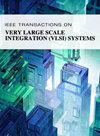3-D Digital Compute-in-Memory Benchmark With A5 CFET Technology: An Extension to Lookup-Table-Based Design
IF 3.1
2区 工程技术
Q2 COMPUTER SCIENCE, HARDWARE & ARCHITECTURE
IEEE Transactions on Very Large Scale Integration (VLSI) Systems
Pub Date : 2025-03-21
DOI:10.1109/TVLSI.2025.3566346
引用次数: 0
Abstract
Digital compute-in-memory (DCIM) has emerged as a promising solution to address scalability and accuracy challenges in analog compute-in-memory (ACIM) for next-generation AI hardware acceleration. In this work, we present a comprehensive device-to-system codesign process for the two proposed 3-D DCIM architectures at the projected 5 angstrom (A5) complementary FET (CFET) technology node: 1) 3-D DCIM based on 8T DCIM bit cell and 2) lookup-table (LUT)-based 3-D DCIM. A novel A5 CFET-based 8T DCIM bit cell (6T SRAM +2T AND gate) is proposed to improve total footprint and latency over the conventional 10T DCIM bit cell, and its functionality is verified through technology computer-aided design (TCAD) simulation. For macro- and system-level evaluation of the proposed 3-D DCIM architectures, an extended NeuroSim V1.4 framework is developed, the first compute-in-memory (CIM) benchmark framework enabling CIM simulation at the A5 CFET technology node. We demonstrate that the proposed 3-D DCIM with 8T DCIM bit cell at the A5 CFET technology node can achieve基于A5 CFET技术的三维数字内存计算基准测试:基于查找表设计的扩展
数字内存计算(DCIM)已成为解决下一代人工智能硬件加速中模拟内存计算(ACIM)的可扩展性和准确性挑战的一种有前途的解决方案。在这项工作中,我们在预计的5埃(A5)互补FET (cet)技术节点上为两种提出的3-D DCIM架构提出了一个全面的器件到系统的协同设计过程:1)基于8T DCIM位元的3-D DCIM和2)基于查找表(LUT)的3-D DCIM。提出了一种基于A5 cfet的8T DCIM位元单元(6T SRAM +2T AND gate),与传统的10T DCIM位元单元相比,提高了总占用空间和延迟,并通过计算机辅助设计(TCAD)仿真验证了其功能。为了对提议的3-D DCIM架构进行宏观和系统级评估,开发了扩展的NeuroSim V1.4框架,这是第一个在A5 CFET技术节点上实现CIM仿真的内存计算(CIM)基准框架。我们证明,与最先进的3纳米基于finfet的DCIM设计相比,在A5 CFET技术节点上具有8T DCIM位单元的3-D DCIM可以实现8.2倍的性能因数(FOM)改进(=TOPS/W $\times $ TOPS/mm2)。此外,还提出了基于ut的3-D DCIM设计,以进一步降低基于8T DCIM位单元的3-D DCIM的功耗。与传统的10T DCIM位单元DCIM相比,基于lut3 - d DCIM的能耗降低了44%。我们的研究结果表明,在高性能DCIM设计中,1nm以下的技术缩放具有重要意义。
本文章由计算机程序翻译,如有差异,请以英文原文为准。
求助全文
约1分钟内获得全文
求助全文
来源期刊
CiteScore
6.40
自引率
7.10%
发文量
187
审稿时长
3.6 months
期刊介绍:
The IEEE Transactions on VLSI Systems is published as a monthly journal under the co-sponsorship of the IEEE Circuits and Systems Society, the IEEE Computer Society, and the IEEE Solid-State Circuits Society.
Design and realization of microelectronic systems using VLSI/ULSI technologies require close collaboration among scientists and engineers in the fields of systems architecture, logic and circuit design, chips and wafer fabrication, packaging, testing and systems applications. Generation of specifications, design and verification must be performed at all abstraction levels, including the system, register-transfer, logic, circuit, transistor and process levels.
To address this critical area through a common forum, the IEEE Transactions on VLSI Systems have been founded. The editorial board, consisting of international experts, invites original papers which emphasize and merit the novel systems integration aspects of microelectronic systems including interactions among systems design and partitioning, logic and memory design, digital and analog circuit design, layout synthesis, CAD tools, chips and wafer fabrication, testing and packaging, and systems level qualification. Thus, the coverage of these Transactions will focus on VLSI/ULSI microelectronic systems integration.

 求助内容:
求助内容: 应助结果提醒方式:
应助结果提醒方式:


